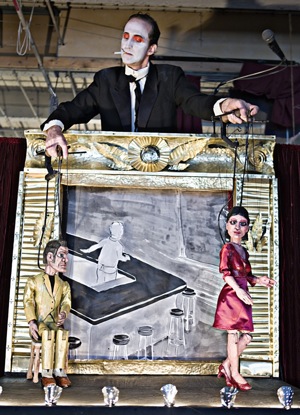Theater Review: The Hard Heart of a Puppet
It is with a strange malice/ that I distort the world. – Wallace Stevens, The Weeping Burgher
Hard Headed Heart. Performed by Blair Thomas & Company. Sets, puppets, and scrolls by Blair Thomas. Translation of the Garcia Lorca play by Catherine Brown. St. James Infirmary puppets by Jess Mooney-Bullock. Curtains and costumes by Heidi Dakter and Sue Haas. At the Charlestown Working Theater, Charlestown, MA, September 12.
Reviewed by Bill Marx
One of the delights, deadly serious as well as childish, of puppetry is how it plays with distortion, squeezing the world down to odd sizes and shapes populated by grotesque distortions of the human figure. The act of metamorphosis not only reflects a sense of fun, of fantastic re-invention, but of malice as well, an urge to manhandle reality, to put it on a string (or is that a leash?). That sense of anarchistic fervor runs through Hard Headed Heart, three solo performances by acclaimed Chicago puppeteer Blair Thomas. Though at times self-indulgent and slow, the show proffers impressive imaginative rewards, from eye-popping and ingenious sets to striking costumes and puppets: the standout of the trio of pieces is “The Blackbird,” a lovely shadow puppet meditation on Wallace Stevens’ poem “Thirteen Ways of Looking at a Blackbird” that serves the poet’s surreal vision with melancholic aplomb.
Thomas literally hammers his worlds down to size. Each of the three shows has its own set, elaborate Rube-Goldbergian machinery whose multiple levels and playing areas, gorgeous tin metal work, ornate lights, and mics allow the performer to take up all the dramatic roles, manipulate the puppets, do the different voices, play music (on a variety of instruments, including toy piano) and speak to the audience. The theatrical metaphor is powerfully visualized: the puppeteer is a marionette as well—caught up in his own creative machinery.
The result of the frenzied activity is exhaustive (for Thomas and the audience) and can be irritatingly show-offy, especially when the performer wallows in his Snidely Whiplash Victorian stage manager persona in the first play, a risqué version of Federico Garcia Lorca’s “The Puppet Show of Don Cristobal.” Your reaction to the piece will depend on your patience with the olde Punch and Judy tradition of club-wielding bully/clowns and punched-up bully/victims. Self-consciously scrambling up the knock-a-bout tradition, Lorca adds a young woman with an insatiable sexual appetite (and a good right hook) to the mix. For me, wooden head-butting still generates laughs, but the thumping mayhem goes on too long. Still, Lorca provides some striking language, and Thomas comes up with some really fabulous touches: my favorite—a lit balloon stands in for an exploding moon.
The next piece, a funereal meditation on the jazz classic “St James Infirmary” plays deftly with themes of illusion and reality—is that Thomas playing the toy piano or is it a tape?—while visualizing a haunting response to the broken romance of the song. Here Thomas uses puppets, a dirge-like arrangement of the tune, and images (on a revolving scroll) to convey what is going in the mind of the singer mourning the untimely death of his lover, who may of died from alcohol or drug abuse. Thomas focuses on dark images of waste (drinking, gambling), sex, and death. The lover appears in a sexy, red dress and then as a skeleton popping out of a coffin. The riff on the tune is moving but ultimately monochromatic; the slow-mo pacing becomes wearying. Listen to Cab Calloway’s swinging version of “St. James Infirmary”: the blues inspire energy as well as paralysis.
Hard Headed Heart’s most successful piece is Thomas’s adaptation of Wallace Stevens’ “Thirteen Ways of Looking at a Blackbird” for shadow puppets. Ben Johnston’s String Quartet #4 provides an apt melodic backdrop for the dadesque pictorial narrative, which centers on a couple coming together and then breaking apart under the indifferent eye of the omnipresent blackbird. The story, along with the poem, is presented on a series of large scrolls, with Thomas hand cranking the images across each screen. Shadow puppets—from a blackbird with a question mark tattooed on his body to cryptic dialogue bubbles—pop up along the way. Perhaps only a puppet show this artfully done could provide such a striking testament to the innocent malice of the heart.
Given the undeniable creativity on display in this production, the next time Blair Thomas & Company come to Boston they should give more than just two performances.
Tagged: Blair Thomas, Charlestown Working Theater, drama, Hard Headed Heart, Puppets, St James Infirmary, The Blackbird, Theater


